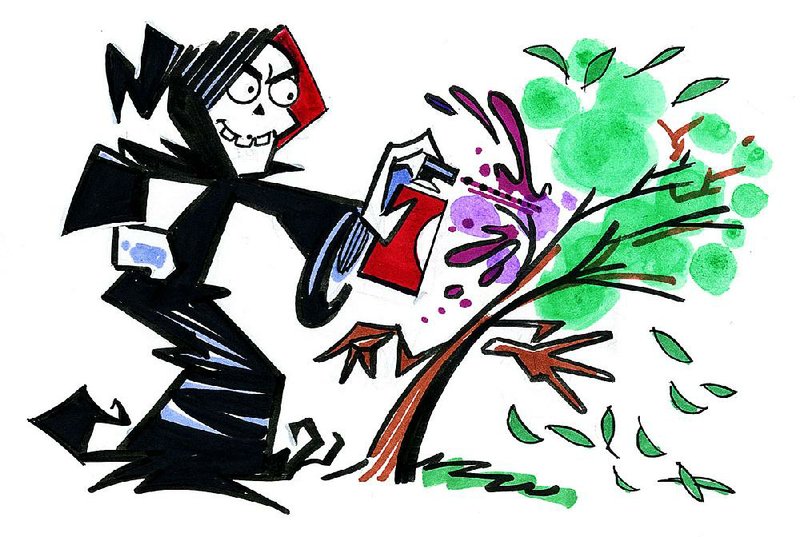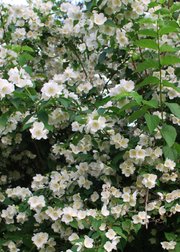Q We have had a Japanese maple for eight or nine years. It was a beautiful tree until August or September when a neighborhood vandal sprayed the front of both it and a crape myrtle with some kind of poison. The front leaves on both trees turned brown, and those on the crape myrtle dropped off. We did not know if either would put out leaves this spring but were hoping for the best. Unfortunately, the best didn't happen. Only leaves in the back came out on the maple; it is too early to know what the crape myrtle will be like after some pruning last month. Is there anything we can do for the maple besides dig it up and plant another? We invested in security cameras immediately after the incident and hope our property will be safer from now on.
A How awful that someone would do such a thing. I think you have a few options. You can prune out all the dead branches and gradually retrain/reshape the tree, but given how slowly cut-leaf dwarf Japanese maples grow, reshaping could take a while. You could replant a whole new tree, or try to find a variety that is similar and plant a smaller tree on the front of the old one to help fill the void left from the dead half.
Q I am one who innocently and ignorantly introduced Vinca major to the wooded border of my backyard about 10 years ago. Starting with a single plant, we now have woodland coverage of about 40 by 50 feet. I understand your view that it is invasive, and I don't argue the fact. What I also see in our specific situation is little, if any, competition; there is nothing here to be crowded out. So I assume the Vinca is helping with erosion control, and it provides some green color in the winter. But what stops it? Surely it must stop spreading at some point or we would be covered completely by now. Removing it seems to be nigh on impossible. Can its perimeter be planted with something that would corral it or even overgrow it, which would not be as bad or worse? Is it always a bad plant?
A From central Arkansas south I would say it is always a bad plant, unless it is grown in a container or has a concrete barrier containing it. Vinca major is not evergreen but is only dormant for a short while. The smaller-leafed form Vinca minor is evergreen and not quite as invasive. Vinca major is tenacious because it is a vining plant that thrives in the shade and can root wherever it touches. You say it has no competition where it is growing, but that could be because it has killed out the smaller native wildflowers or ground cover plants that may have existed before it spread. I work diligently every season to contain mine, and I never planted it -- my neighbor did many years ago. No one maintains this plant, but that doesn't stop it from growing, and it tends to like my yard better than his because I water my yard. Every year I think I am beginning to see light at the end of the tunnel, but then the next spring it is back stronger than ever. Cold weather contains it farther north, and full sun will limit its spread as well, but other than that, watch out. Using a physical barrier such as a concrete border or sheet metal in the ground can help, but Vinca is pretty resourceful.
Q What is the time frame for trimming azaleas after they finish blooming? We live in central Arkansas and have a lot of azaleas. They did not bloom very well, and I fear we didn't time the trimming right last year.
A Some early varieties of azaleas have finished blooming, while others are still in full bloom. Allow your azaleas to totally finish flowering before pruning. Not all azaleas need to be pruned every year. If they need pruning, do so as soon after flowering as possible, but no later than mid-June. Azaleas set their flower buds in late summer through early fall, and we want to allow them time to rebound after pruning to set copious blooms. I would fertilize them once a year after bloom.
Q What is the name of this plant? I have heard English dogwood but never the real name. It is actually invasive but I happen to have it in an area to control its shoots.
A The plant in question is commonly called English dogwood or mock orange. The Latin name is Philadelphus. It is a wonderful, old-fashioned shrub that has arching canes with fragrant white blooms in late spring. It is one of the last of the spring bloomers to bloom. If any pruning is needed, thin out some of the older canes at the bottom. I have never thought it to be invasive, but it can begin to spread with age.
Q I have been babying a couple of redbud tree starts the past two years. They are now ready to be planted at the edge of my yard. They are about 2 to 3 feet tall. Would it be best to plant now or in the autumn? I also want to plant a flowering quince bush. Should I do so now or in the fall?
A I would recommend waiting until fall to move the redbud trees. We are about to enter summer, and transplanting now would be a shock to the plant. If you are buying a container-grown quince, then now would be a fine time to plant, as long as you are willing and able to water. If you are moving existing quince, wait for fall.
Janet B. Carson is a horticulture specialist for the University of Arkansas Cooperative Extension Service. Write to her at 2301 S. University Ave., Little Rock, Ark. 72204 or email her at
jcarson@arkansasonline.com
HomeStyle on 05/07/2016

